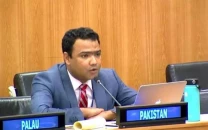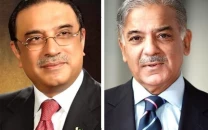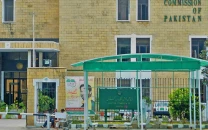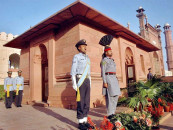Twitter urged to block accounts spreading ‘fake information’ against Pakistan
Move comes after Indian media organisations fabricated 'Karachi civil war' claims

The Indian media’s hostility towards Pakistan is laid bare yet again with relaying and posting of totally false news about a ‘civil war’ and pitched street battles in a fictitious ‘Gulshan-e-Bagh’ locality of Karachi on the TV channels as well as the social media accounts.
In the wake of a smear campaign, not only the Pakistani politicians and social media activists slammed the spread of false information, senior Indian journalists and activists called it unfortunate propaganda by some big media houses.
The Pakistan Telecommunication Authority (PTA) asked the microblogging website, Twitter, to block handles involved in spreading false and baseless information targeting Pakistan with hashtags ‘CivilWarinKarachi’ and ‘CivilWarinPakistan’ etc.
In the wake of current smear campaign of spreading false and baseless information targeting Pakistan, its cities and institutions, PTA has stressed upon Twitter to effectively block handles involved in the campaign. pic.twitter.com/Rnt9sLeCAu
— PTA (@PTAofficialpk) October 22, 2020
On Wednesday, several Indian news outlets, including India Today, Zee News, CNN18 and India.com reported a “civil war-like situation”, in Karachi, a day after an inquiry was ordered by Army Chief Gen Qamar Javed Bajwa into the circumstances surrounding the arrest of Capt (retd) Mohammad Safdar.
Some reports cited “source” as saying that clashes had been reported in the country’s financial hub between the Sindh police and the army. A fake video was also circulated on Twitter, claiming to show the alleged clash. However, it was later deleted.
CNN NEWS18, which is a partnership between India’s TV18 and CNN International, also shared a similar video on Twitter, which went as far as to claim that “a martial law has been imposed in Sindh”.
If this absurdity was not enough, the Indian media got carried away a little bit more, claiming pitched gun battles between rival forces and bombings in an imaginary area in Karachi called — quite ridiculously — “Gulshan-e-Bagh”.
The dissemination of the fake news involved the verified Twitter accounts of India’s major news outlets such as India Today, Zee News English, CNN News18, and India.com. As the tweets started trending, Pakistanis replied with their own spin on the hyperbole in the form of memes.
In the wake of the hate material, the PTA approached the Twitter administration to immediately sensitise its moderation teams and ensure that the platform was not used as a propaganda tool for spreading fake information.
“In the wake of current smear campaign of spreading false and baseless information targeting Pakistan, its cities and institutions, the PTA has stressed upon Twitter to effectively block handles involved in the campaign,” said a press release issued in Islamabad on Thursday.
“To the disappointment of the regulator, the number of accounts involved in the propagation of untrue stories, are Twitter verified. However, they are still operating with immunity,” the PTA said, urging Twitter to block handles involved in this malicious campaign.
Several politicians, including federal ministers, as well as social media activists also called on Twitter’s support team to look into the fake news and curb the spread of false information through its platform.
Human Rights Minister Shireen Mazari called the Indian media out, tagging Twitter Support’s official account in her tweet, saying that they were “deliberately ignoring” the spread of disinformation against Pakistan. “Indian media in hyper drive with fake news on Pakistan.”
Mazari’s views were endorsed by Parliamentary Kashmir Committee Chairman Shehryar Afridi. “Twitter needs to take action against Indian social media accounts who are involved in nefarious attacks of fake news against Pakistan.”
Indian media in hyper drive with fake news on Pakistan & unfortunate that @TwitterSupport delib ignoring! Facebook also indulging Indian propaganda & hate posts! Similarly Islamophobia rampant but heaven forbid if any word said implying even a querying comment on holocaust! https://t.co/F6h0Q6vRwD
— Shireen Mazari (@ShireenMazari1) October 22, 2020
Maritime Affairs Minister Ali Haider Zaidi said the Indian media propaganda was at its peak and was being fuelled by the PDM “circus”. “Both social and economic indicators of Pakistan are showing positive signs. The artificially manufactured food inflation is being brought under control as well.”
According to data released by the Islamabad Institute of Policy Research (IPRI), the Indian digital media had engaged in systematic propaganda against Pakistan which had grew exponentially following the 2018 general elections.
The spread of fake news about Pakistan has also been condemned by senior journalists saner elements in India, who raised questions how it was possible that a civil war erupted in a country and only Indian media knew it and none else.
“It is unfortunate that today big media houses broadcast news without verification that has nothing to do with reality or that the news is taken out of context,” and Amritsar-based senior India journalist said. “Unfortunately, [they] do not want to improve relations between India and Pakistan.”
“The job of a journalist is to convey accurate and factual information to the people but there are many media houses that work for the interests and agenda of the governments,” added another senior journalist Ravinder Singh Robin.
Many Indian intellectuals and analysts have also called the anti-Pakistan news on the Indian media as “ridiculous” and expressed surprise at what kind of clash had taken place in Pakistan which was reported by a few media houses in India and the rest of the did not know about it.
IPRI Infolytics| Timeline of Indian Propaganda
— Islamabad Policy Research Institute (@IPRI_Pakistan) October 21, 2020
Our data indicates a pattern of Indian propaganda against Pakistan on digital media that grew exponentially after 2018 General Elections in #Pakistan. The propaganda hovers around largely 4 key themes. pic.twitter.com/S8LyzD0cha



















COMMENTS
Comments are moderated and generally will be posted if they are on-topic and not abusive.
For more information, please see our Comments FAQ